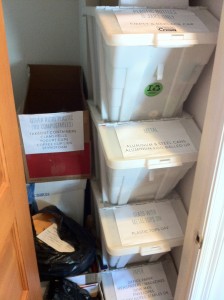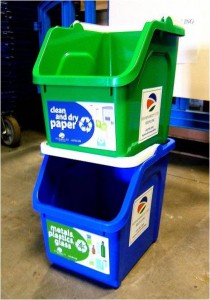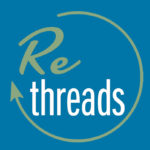Source Separation
Source separation requires the consumer to separate all materials by type at the point of discard so they can be recycled. It may also be referred to as dual or sorted stream recycling. Source separation may mean separating all recyclables by type- meaning metal, glass, paper, and plastic, as seen in this picture of GreenBlue’s office recycling:
Alternatively, source separation can mean separating paper from other recyclable materials (bottles and cans) at the point of discard for further separation later. Dual stream protects paper, a valuable commodity, from becoming contaminated by food waste clinging to the inside of jars and cans. You can find this system on the Grounds of the University of Virginia:
Pros
- Lower levels of contamination
- Higher quality and more valuable material
- Doe snot rely on expensive sorting technology, leading to lower costs
Cons
- Requires more consumer effort
- Can result in low participation rates, especially in areas with low recycling ethics
Bottom Line
Separating materials by type at the point of discard, though time-consuming, reduces contamination and increases quality of recovery to over 90%. Source separation does require effective communication and education to ensure items are placed in the correct stream. However consumer effort and engagement can be beneficial as it raises awareness about what can and cannot be recycled, encouraging individuals to take responsibility for the resources they consume and make lifestyle changes.






